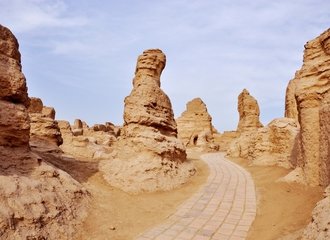Tibetan opera
Tibetan Opera, which is called Lhamo or Ace Lhamo in Tibetan, is the traditional opera of Tibet. Tibetan Opera is the earliest form of opera among minorities in China. It is very popular in Tibet, especially in Shannan , Shigatse , Lhasa , and Chamdo Region , and also widespread in Sichuan, Gansu, Qinghai and Yunnan Provinces.
Tibetan Opera is a combination of songs, dances, chants and drama, with most of its repertoire deriving from Buddhist teachings and Tibetan history. There are many thoughts about its origin. It is said that in the 8th century Buddhism prevailed in Tibet. The king Trisong Detsen invited an Indian hierarch, Padmasambhava to Tibet to facilitate Buddhism. Padmasambhava compiled many plays according to Tibetan folk songs, dances and Buddhist stories. These plays, once used to sacrifice Buddha and promote Buddhist philosophy, are regarded as the essence of Tibetan Opera. In the 14th century, a hierarch named Drupthok Thangthong Gyalpo designed aria and obbligato, and added dramatic elements to the plays. He also arranged performances and instructed seven pretty girls to act them out to raise funds to improve transportation in Tibet. Such performances gradually developed into Tibetan Opera and became very popular around Tibet. The seven girls were so pretty and so adept in singing and dancing that they were praised as Lhamo, which means 'fairy' in Tibetan. Tibetan Opera was also called Lhamo or Ace Lhamo thereafter.
Since the 17th century, Tibetan Opera has had a rapid development and reached its peak with a long list of excellent players and traditional repertoires. Different genres evolved, each with a certain style. Performances were held during various festive occasions. The Shoton Festival which was once a religious festival became a special festive occasion of Tibetan Opera joint performance, during which many professional and amateur troupes were summoned to Lhasa to entertain the Dalai Lama and his followers.
Tibetan Opera performances follow fixed procedures. Every performance begins with a fete of purifying the stage, a blessing to the God and a narrator singing the summary of the story in verse. Then in the main part of the opera, a narrator will expansively introduce the story, the characters and the libretto in rapid repetitive rhythm. Following that all the players enter and start singing and dancing. The performance ends with a ritual of blessing, also with all players participating. The highlight of the performance is its masks, through which the role of the players can be identified. The masks have various colors and motifs, each indicating a certain meaning. For example, the red mask refers to the king, the green the queen, while the yellow the lamas.
In the past, Tibetan Opera was only held outdoors, and each player only had one costume throughout the performance. Since the 1960s, Tibetan Opera has been performed indoors with lighting, backdrop, set, orchestral obbligato and a number of modern themes added. In addition, it has developed into a higher level with connections with Beijing Opera. The play Princess Wencheng, which was put on not long ago, is a masterpiece of the combination of Tibetan Opera and Beijing Opera. It is a visual feast boasting spectacular scenes, vivid characters and an excellent performance.





















